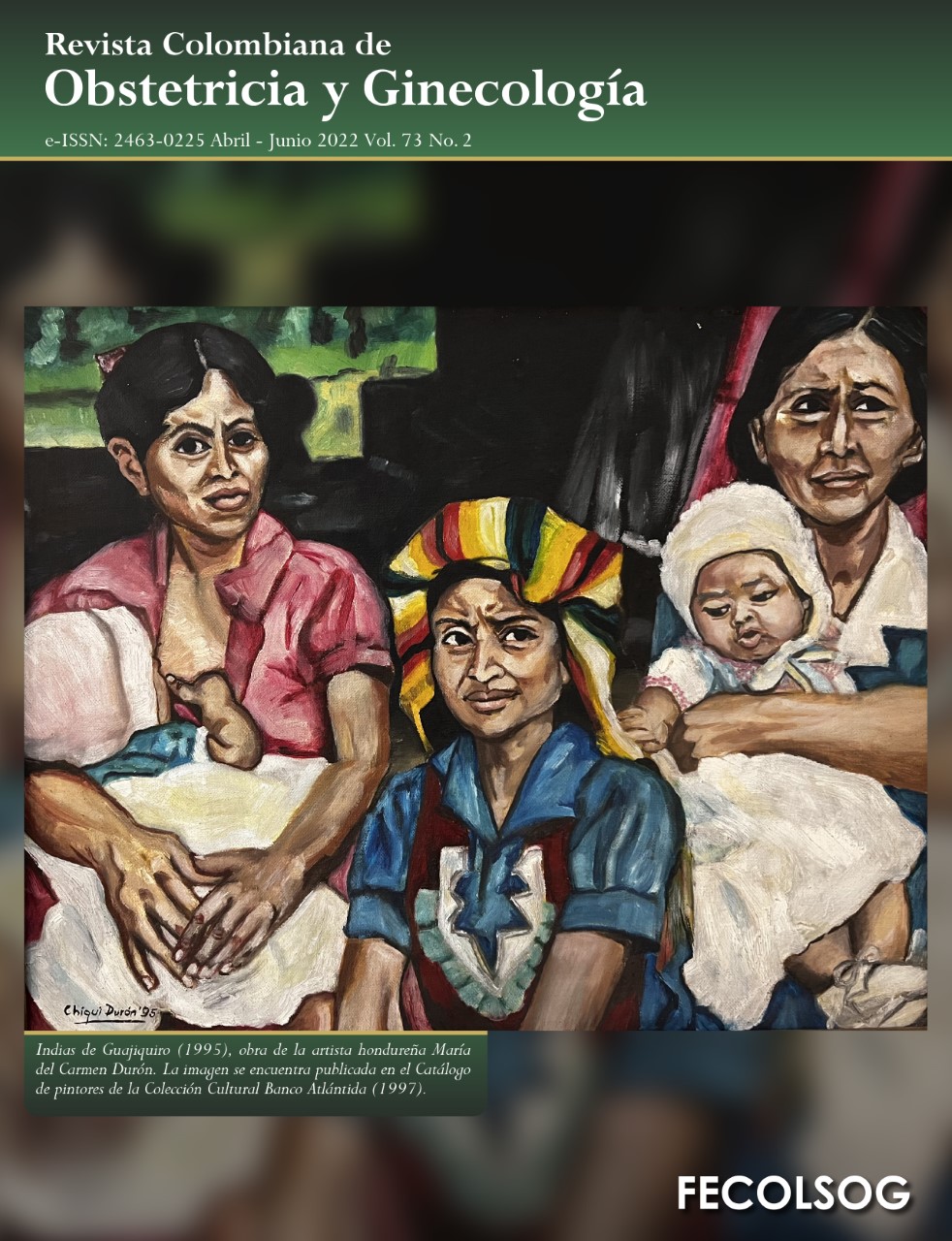Predictive performance of fetal growth restriction criteria for adverse perinatal outcomes in a hospital in Popayán, Colombia
DOI:
https://doi.org/10.18597/rcog.3840Keywords:
Fetal growth restriction, pulsed Doppler ultrasound, perinatal demise, neonatal death, adverse composite neonatal outcomeAbstract
Objectives: To determine the predictive performance of fetal growth restriction by Maternal Fetal Medicine Society (MFMS) definition of ultrasound, the Delphi consensus (DC) and the Barcelona Fetal Medicine (BFM) criteria for adverse perinatal outcomes, and to identify whether there is an association between the diagnosis of fetal growth restriction (FGR) and adverse perinatal outcomes.
Material and methods: A retrospective cohort study was conducted including women with singleton pregnancies between 24 and 36 weeks of gestation seen at the maternal fetal medicine unit for ultrasound assessment of fetal growth and delivery care in a public referral hospital in Popayán, Colombia. Pregnancies with ultrasound findings of congenital abnormalities were excluded. Convenience sampling was used. Sociodemographic and clinical variables were measured on admission; additional variables were gestational age, FGR diagnosis and adverse composite perinatal outcome. The predictive ability of three fetal growth restriction diagnostic criteria for poor perinatal outcomes was analyzed and asociation between FGR and adverse perinatlal outcomes.
Results: Overall, 228 pregnant women with a mean age of 26.8 years were included; FGR prevalence according to the three criteria was 3.95 %, 16.6 % and 21.9 % for DC, BFM and MFMS, respectively. None of the criteria resulted in an acceptable area under the curve for the prediction of the composite adverse neonatal outcome; FGR diagnosis by DC and MFMS were associated with adverse perinatal outcomes with a RR of 2.6 (95 % CI: 1.5-4.3) and 1.57 (95 % CI: 1.01-2.44) respectively. No association was found for BFM RR: 1.32 (95 % CI: 0.8-2.1).
Conclusions: Given a positive result for FGR, the Delphi method is significantly associated with adverse perinatal outcomes. The proportion of false negative results for a poor perinatal outcome is high for the three methods. Prospective studies that reduce measurement and attrition bias are required.
Author Biographies
Oscar Octalivar Gutiérrez-Montufar, Universidad del Cauca, Popayán (Colombia).
Residente de Ginecología y Obstetricia de la Universidad del Cauca, Popayán (Colombia).
Oscar Enrique Ordoñez-Mosquera, Universidad del Cauca, Popayán (Colombia).
Docente Universidad del Cauca, Popayán (Colombia).
Mónica Alejandra Rodríguez-Gamboa , Hospital Universitario San José, Popayán (Colombia).
Médico Hospital Universitario San José, Popayán (Colombia).
Javier Andrés Castro-Zúñiga, Universidad del Cauca, Popayán (Colombia).
Docente Universidad del Cauca, Popayán (Colombia).
Jhon Edison Ijaj- Piamba, Universidad del Valle, Cali (Colombia).
Docente Universidad del Valle, Cali (Colombia).
Roberth Alirio Ortiz-Martínez, Universidad del Cauca, Popayán (Colombia).
Docente Universidad del Cauca, Popayán (Colombia). Docente Universidad del Valle, Cali (Colombia).
References
Platz E, Newman R. Diagnosis of IUGR: Traditional Biometry. Vol. 32, Seminars in Perinatology. 2008. p.140–7. https://doi.org/10.1053/j.semperi.2008.02.002
Gordijn SJ, Beune IM, Thilaganathan B, Papageorghiou A, Baschat AA, Baker PN, et al. Consensus definition of fetal growth restriction: a Delphi procedure. Vol. 48, Ultrasound in Obstetrics & Gynecology. 2016. p. 333–9. https://doi.org/10.1002/uog.15884
Romo A, Carceller R, Tobajas J. Intrauterine growth retardation (IUGR): epidemiology and etiology. Pediatr Endocrinol Rev. 2009 ;6 Suppl 3:332-6.
Onis M, Blössner M, Villar J. Levels and patterns of intrauterine growth retardation in developing countries. Eur J Clin Nutr. 1998 ;52 Suppl 1:S5-15. PMID: 9511014.
Melamed N, Baschat A, Yinon Y, Athanasiadis A, Mecacci F, Figueras F, et al. FIGO (international Federation of Gynecology and obstetrics) initiative on fetal growth: best practice advice for screening, diagnosis, and management of fetal growth restriction. Int J Gynaecol Obstet. 2021;152 Suppl 1:3–57. https://doi.org/10.1002/ijgo.13522
Ego A, Subtil D, Grange G, Thiebaugeorges O, Senat MV, Vayssiere C, et al. Customized versus population-based birth weight standards for identifying growth restricted infants: a French multicenter study. Am J Obstet Gynecol. 2006 194(4):1042-9. https://doi.org/10.1016/j.ajog.2005.10.816.
Lees CC, Stampalija T, Baschat A, da Silva Costa F, Ferrazzi E, Figueras F, et al. ISUOG Practice Guidelines: diagnosis and management of small-for-gestational-age fetus and fetal growth restriction. Ultrasound Obstet Gynecol. 2020;56(2):298–312. https://doi.org/10.1002/uog.22134
Sharma D, Farahbakhsh N, Shastri S, Sharma P. Intrauterine growth restriction - part 2. J Matern Fetal Neonatal Med. 2016;29(24):4037–48. https://doi.org/10.3109/14767058.2016.1154525
Fetal Growth Restriction: ACOG Practice Bulletin, Number 227. Obstet Gynecol. 2021;137(2):e16–28. https://doi.org/10.1097/aog.0000000000004251
Martins JG, Biggio JR, Abuhamad A. Society for Maternal-Fetal Medicine Consult Series #52: Diagnosis and management of fetal growth restriction. Vol. 223, American Journal of Obstetrics and Gynecology. 2020. p. B2–17. https://doi.org/10.1016/j.ajog.2020.05.010
Figueras F, Gómez L, Eixarch E, Paules C, Pérez M, Meler E, et al. Protocolo: Defectos de crecimiento fetal. Servicio de Medicina Maternofetal Hospital Clinic y Hospital Sant Joan de Deu - Universidad de Barcelona. 2019.
Molina LCG, Odibo L, Zientara S, Običan SG, Rodriguez A, Stout M, et al. Validation of Delphi procedure consensus criteria for defining fetal growth restriction. Vol. 56, Ultrasound in Obstetrics & Gynecology. 2020. p. 61–6. https://doi.org/10.1002/uog.20854
Fletcher R, Fletcher S, Wagner E. Diagnosis. Chapter 3 (1996). En Fletcher R, Fletcher S, Wagner E (3ra Ed). Clinical epidemiology the essentials (pp 43-74) Williams & Wilkins.
Hadlock FP, Harrist RB, Martinez-Poyer J. In utero analysis of fetal growth: a sonographic weight standard. Radiology. 1991;181(1):129-133. https://doi.org/10.1148/radiology.181.1.1887021
Salomon LJ, Alfirevic Z, Da Silva Costa F, Deter RL, Figueras F, Ghi T, et al. ISUOG Practice Guidelines: ultrasound assessment of fetal biometry and growth. Ultrasound Obstet Gynecol. 2019;53(6):715–23. https://doi.org/10.1002/uog.20272
Liauw J, Mayer C, Albert A, Fernandez A, Hutcheon JA. Which chart and which cut-point: deciding on the INTERGROWTH, World Health Organization, or Hadlock fetal growth chart. BMC Pregnancy Childbirth. 2022;22(1):25. https://doi.org/10.1186/s12884-021-04324-0
Roeckner JT, Pressman K, Odibo L, Duncan JR, Odibo AO. Outcome-based comparison of SMFM and ISUOG definitions of fetal growth restriction. Vol. 57, Ultrasound in Obstetrics & Gynecology. 2021. p. 925–30. https://doi.org/10.1002/uog.23638
How to Cite
Downloads
Published
Issue
Section
License

This work is licensed under a Creative Commons Attribution-NonCommercial-NoDerivatives 4.0 International License.
| Article metrics | |
|---|---|
| Abstract views | |
| Galley vies | |
| PDF Views | |
| HTML views | |
| Other views | |
















